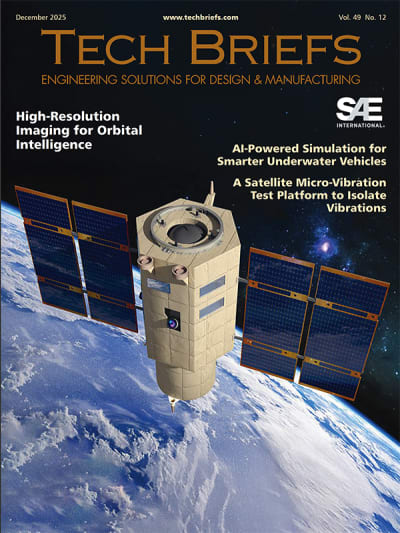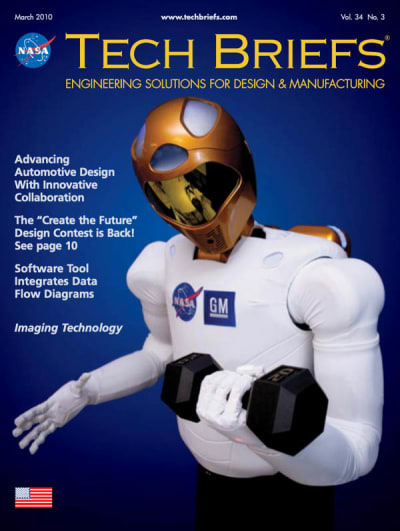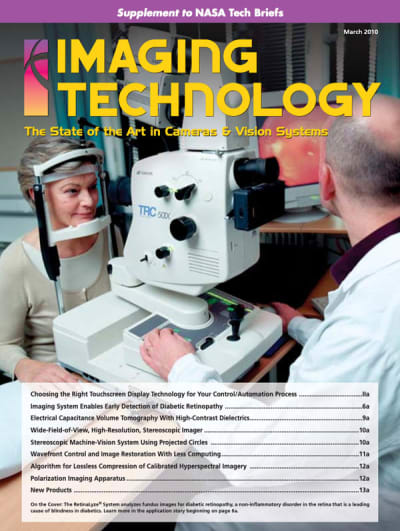Inside this issue
Overview
The March 2010 edition of NASA Tech Briefs, along with its supplements on Imaging Technology and Embedded Technology, presents a comprehensive overview of the latest advancements and innovations in various fields, particularly focusing on automotive design, imaging systems, and automation technologies.
Key Highlights:
-
Advancing Automotive Design: The issue opens with a feature on the "Create the Future" Design Contest, which encourages innovative ideas in automotive design. This contest aims to inspire engineers and designers to think creatively about the future of transportation, emphasizing the importance of collaboration and innovation in the automotive industry.
-
Imaging Technology: A significant portion of the magazine is dedicated to the state of the art in cameras and vision systems. This includes discussions on various imaging technologies that are crucial for applications ranging from medical diagnostics to industrial automation. Notable advancements include:
- Early Detection of Diabetic Retinopathy: An imaging system that analyzes fundus images to detect diabetic retinopathy, a leading cause of blindness in diabetics. This technology highlights the intersection of healthcare and imaging technology, showcasing how advanced imaging can lead to better patient outcomes.
- Electrical Capacitance Volume Tomography: This technology utilizes high-contrast dielectrics to improve imaging capabilities, which can be particularly beneficial in industrial applications where precise measurements are critical.
-
Touchscreen Display Technology: The magazine features an article on choosing the right touchscreen display technology for control and automation processes. It emphasizes the importance of selecting an HMI (Human-Machine Interface) that meets specific application requirements. Key considerations include:
- The reliability of the HMI provider, particularly in terms of technical support and repair services. The article stresses that a good support system is essential to minimize downtime in operations, as HMI failures can lead to significant disruptions.
- The wide range of HMI options available, which allows businesses to find solutions that fit their budget and automation goals. The importance of thorough research before making a purchase decision is highlighted.
Innovative Imaging Systems: The issue also covers various innovative imaging systems, including:
- Stereoscopic Machine-Vision Systems: These systems utilize projected circles to enhance depth perception and accuracy in imaging, which can be crucial for applications in robotics and automation.
- Wavefront Control and Image Restoration: This technology focuses on improving image quality through advanced algorithms, which can be particularly useful in scientific and industrial imaging applications.
-
Algorithm Development: An article discusses the development of algorithms for lossless compression of calibrated hyperspectral imagery. This technology is vital for efficiently storing and transmitting large amounts of imaging data without losing critical information, which is essential in fields such as remote sensing and environmental monitoring.
-
New Products and Innovations: The magazine features a section on new products that are making waves in the technology sector. This includes advancements in embedded systems, which are becoming increasingly important in various applications, from consumer electronics to industrial automation.
-
Understanding Virtex FPGAs: A technical article delves into the complexities of Virtex FPGAs (Field-Programmable Gate Arrays), explaining their significance in modern computing and how they can be utilized in various applications, including telecommunications and data processing.
-
Multicore Processing: The issue also addresses the challenges and potential pitfalls of multicore processing, discussing whether it represents a technological dead end or a pathway to greater efficiency in computing.
-
Embedded Form Factors: Another article explores the application of embedded form factors in wireless systems, highlighting how these compact designs can lead to more efficient and powerful devices.
Conclusion: The March 2010 edition of NASA Tech Briefs, along with its supplements, serves as a valuable resource for professionals in engineering, technology, and design. It provides insights into the latest trends and innovations that are shaping the future of various industries. From automotive design to advanced imaging systems and embedded technologies, the magazine emphasizes the importance of research, collaboration, and innovation in driving progress. Readers are encouraged to engage with the content and consider how these advancements can be applied to their own work and projects.
Features
-
Application Briefs
High-Flex Cable Assembly to Aid Robot Arm in Mars Exploration Program
Avionics Databus to Promote Systems Integration on Orion Vehicle
Tech Briefs
-
Physical Sciences
Profiling the Atmosphere by Use of an Elevated GPS Receiver
Thermal Detection of Gas in a Tube Containing Flowing Liquid
Adaptive Nulling for Interferometric Detection of Planets
Cryogenic Transport of High-Pressure-System Recharge Gas
Water-Vapor Raman Lidar System Reaches Higher Altitude
Compact Ku-Band T/R Module for High-Resolution Radar Imaging of Cold Land Processes
-
Manufacturing & Prototyping
Chemical Machining of Microscopic Holes and Grooves in Glass
Venting Closed-Cell Foam Panels
-
Software
Processing AIRS Scientific Data Through Level 3
-
Materials
Electroceramic Actuators for Operation at Low Temperatures
Database for Safety-Oriented Tracking of Chemicals
Optimized Li-Ion Electrolytes Containing Fluorinated Ester Co-Solvents
Probabilistic Multi-Factor Interaction Model for Complex Material Behavior
-
Information Sciences
Software Tool Integrating Data Flow Diagrams and Petri Nets
Reducing the Volume of NASA Earth-Science Data
Tropospheric Emission Spectrometer Product File Readers
Reporting Differences Between Spacecraft Sequence Files
Performance Bounds on Two Concatenated, Interleaved Codes
Mission Reliability Estimation for Repairable Robot Teams
Algorithm for Stabilizing a POD-Based Dynamical System
Parameterizing Coefficients of a POD-Based Dynamical System
Confidence-Based Feature Acquisition
-
Mechanics & Machinery
Foldable Instrumented Bits for Ultrasonic/Sonic Penetrators
Compact Rare Earth Emitter Hollow Cathode
High-Precision Shape Control of In-Space Deployable Large Membrane/Thin-Shell Reflectors
-
Electronics & Computers
Reception of Multiple Telemetry Signals via One Dish Antenna
Space-Qualified Traveling-Wave Tube
Smart Power Supply for Battery-Powered Systems
Parallel Processing of Broad-Band PPM Signals
Products
-
Briefs
Electrical Capacitance Volume Tomography With High-Contrast Dielectrics
Stereoscopic Machine-Vision System Using Projected Circles
Wavefront Control and Image Restoration With Less Computing
Wide-Field-of-View, High-Resolution, Stereoscopic Imager
Algorithm for Lossless Compression of Calibrated Hyperspectral Imagery
-
Applications
-
Articles
Making Sense Out of SOUP (Software of Unknown Pedigree)
-
Briefs
Sliding Mode Pulsed Current Averaging IC Drivers for High-Brightness Light Emitting Diodes
Development of Advanced LED Phosphors by Spray-based Processes for Solid-State Lighting





